A Report on the Operation and Performance of Turbine Engines
VerifiedAdded on 2019/10/30
|5
|805
|308
Report
AI Summary
This report provides a comprehensive analysis of turbine engine operation and performance. It begins with an overview of the turbine engine system, detailing the role of various components like the compressor, combustion chamber, and turbine. The report then delves into the four key cycles: intake, compression, expansion, and exhaust, explaining each cycle's function within the engine. Further, it describes the operational procedures, including engine start-up, shutdown, and the procedures followed in case of engine failure or crash, emphasizing the importance of safety protocols. The report references several academic sources to support its claims, offering a well-rounded understanding of the subject matter.
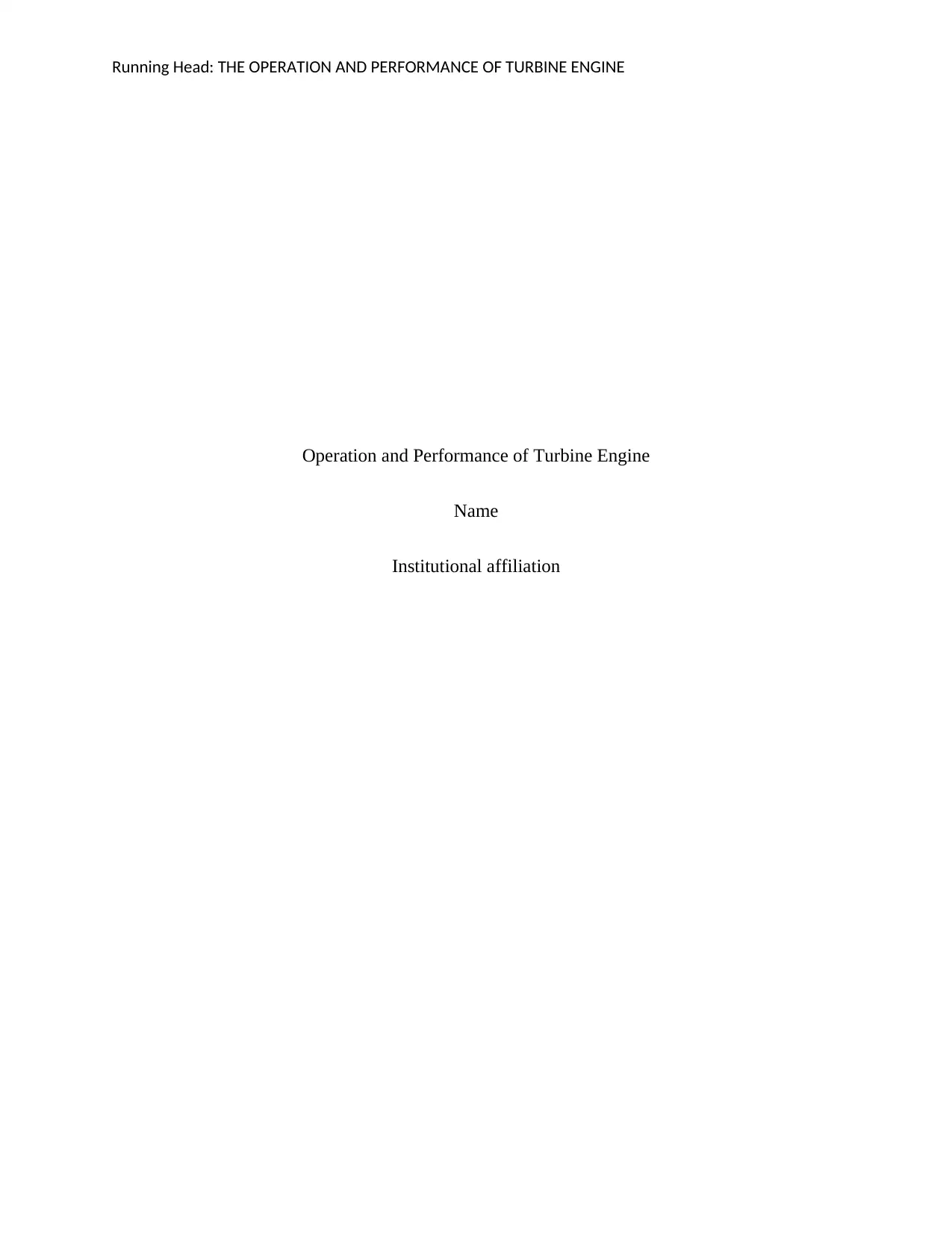
Running Head: THE OPERATION AND PERFORMANCE OF TURBINE ENGINE
Operation and Performance of Turbine Engine
Name
Institutional affiliation
Operation and Performance of Turbine Engine
Name
Institutional affiliation
Paraphrase This Document
Need a fresh take? Get an instant paraphrase of this document with our AI Paraphraser
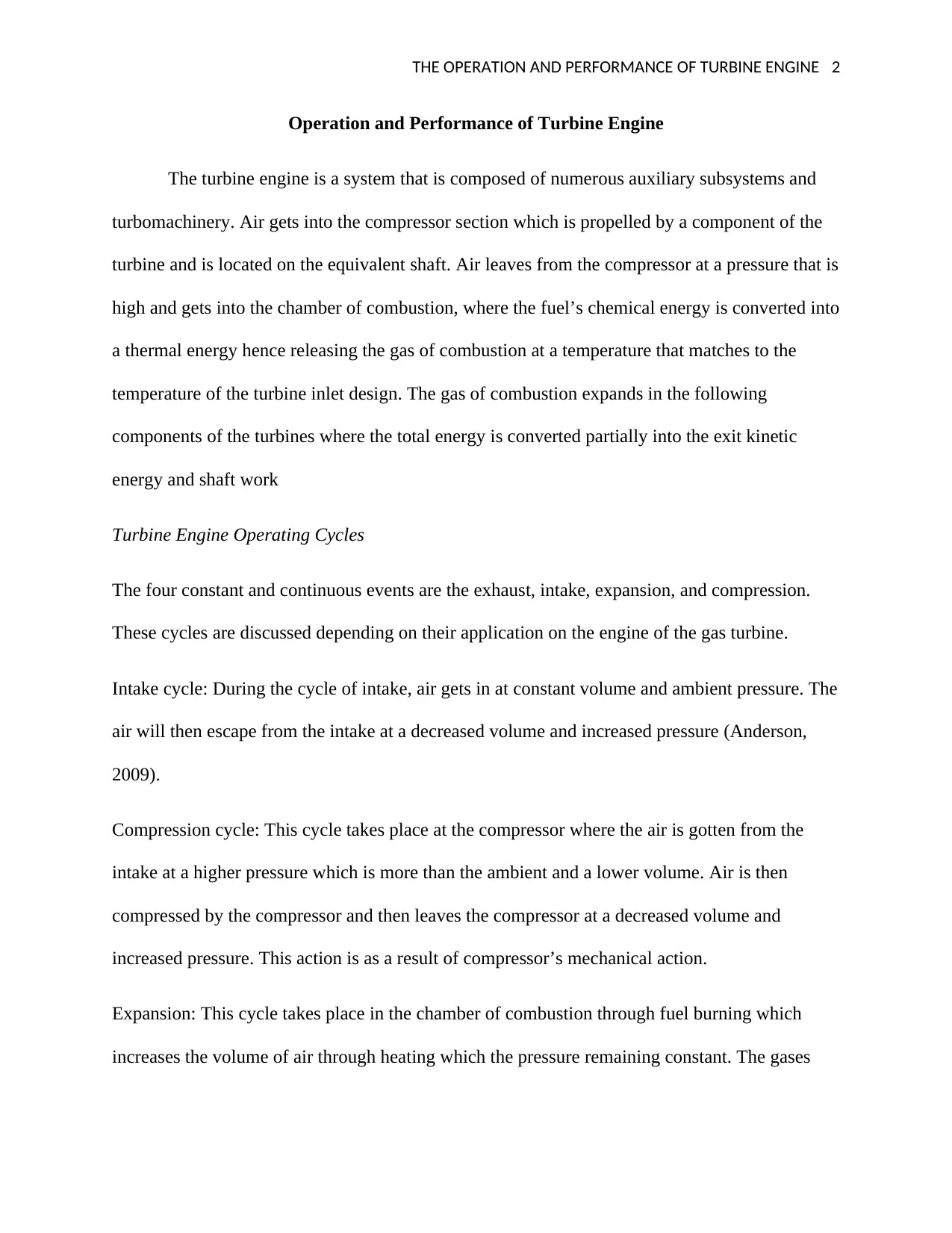
THE OPERATION AND PERFORMANCE OF TURBINE ENGINE 2
Operation and Performance of Turbine Engine
The turbine engine is a system that is composed of numerous auxiliary subsystems and
turbomachinery. Air gets into the compressor section which is propelled by a component of the
turbine and is located on the equivalent shaft. Air leaves from the compressor at a pressure that is
high and gets into the chamber of combustion, where the fuel’s chemical energy is converted into
a thermal energy hence releasing the gas of combustion at a temperature that matches to the
temperature of the turbine inlet design. The gas of combustion expands in the following
components of the turbines where the total energy is converted partially into the exit kinetic
energy and shaft work
Turbine Engine Operating Cycles
The four constant and continuous events are the exhaust, intake, expansion, and compression.
These cycles are discussed depending on their application on the engine of the gas turbine.
Intake cycle: During the cycle of intake, air gets in at constant volume and ambient pressure. The
air will then escape from the intake at a decreased volume and increased pressure (Anderson,
2009).
Compression cycle: This cycle takes place at the compressor where the air is gotten from the
intake at a higher pressure which is more than the ambient and a lower volume. Air is then
compressed by the compressor and then leaves the compressor at a decreased volume and
increased pressure. This action is as a result of compressor’s mechanical action.
Expansion: This cycle takes place in the chamber of combustion through fuel burning which
increases the volume of air through heating which the pressure remaining constant. The gases
Operation and Performance of Turbine Engine
The turbine engine is a system that is composed of numerous auxiliary subsystems and
turbomachinery. Air gets into the compressor section which is propelled by a component of the
turbine and is located on the equivalent shaft. Air leaves from the compressor at a pressure that is
high and gets into the chamber of combustion, where the fuel’s chemical energy is converted into
a thermal energy hence releasing the gas of combustion at a temperature that matches to the
temperature of the turbine inlet design. The gas of combustion expands in the following
components of the turbines where the total energy is converted partially into the exit kinetic
energy and shaft work
Turbine Engine Operating Cycles
The four constant and continuous events are the exhaust, intake, expansion, and compression.
These cycles are discussed depending on their application on the engine of the gas turbine.
Intake cycle: During the cycle of intake, air gets in at constant volume and ambient pressure. The
air will then escape from the intake at a decreased volume and increased pressure (Anderson,
2009).
Compression cycle: This cycle takes place at the compressor where the air is gotten from the
intake at a higher pressure which is more than the ambient and a lower volume. Air is then
compressed by the compressor and then leaves the compressor at a decreased volume and
increased pressure. This action is as a result of compressor’s mechanical action.
Expansion: This cycle takes place in the chamber of combustion through fuel burning which
increases the volume of air through heating which the pressure remaining constant. The gases
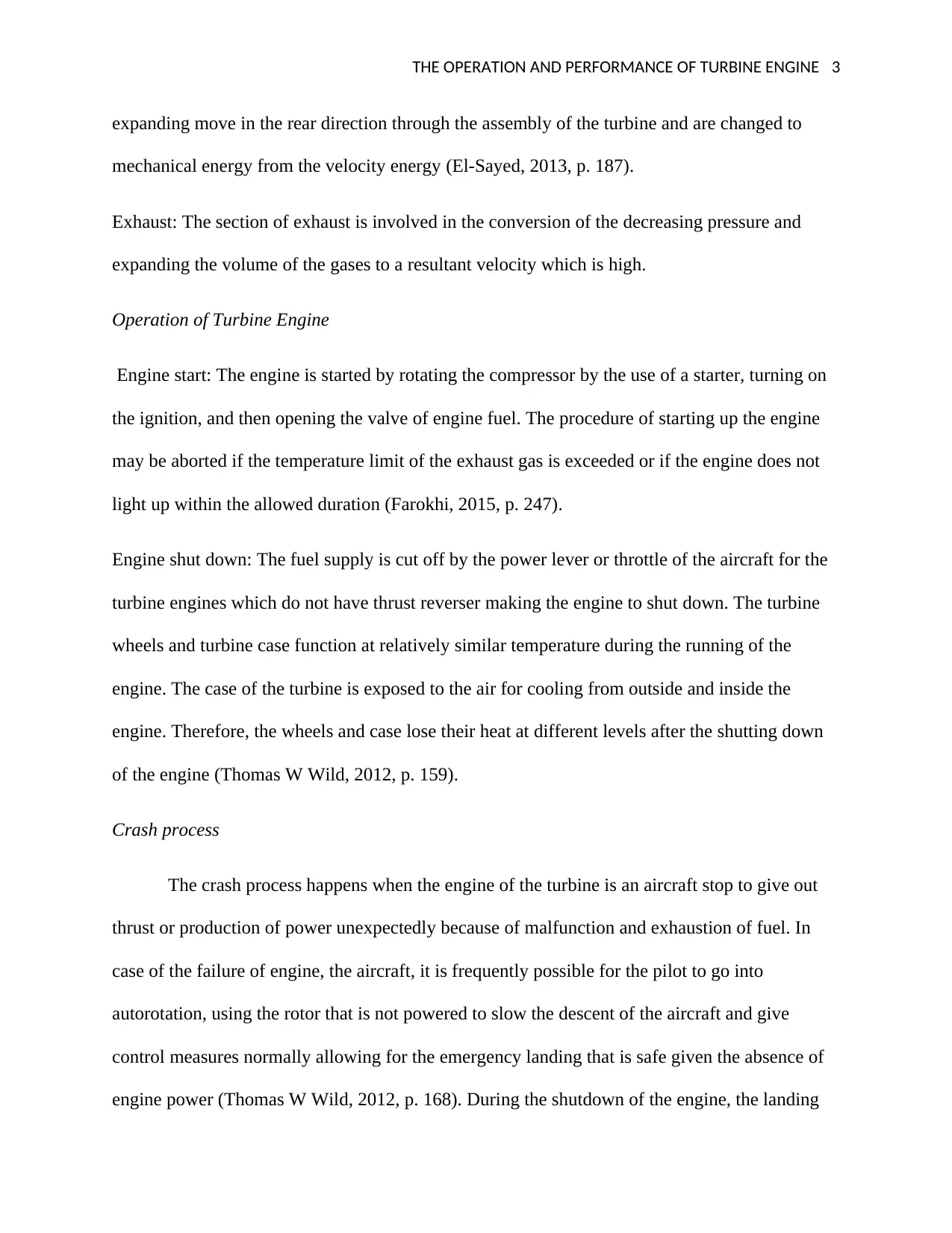
THE OPERATION AND PERFORMANCE OF TURBINE ENGINE 3
expanding move in the rear direction through the assembly of the turbine and are changed to
mechanical energy from the velocity energy (El-Sayed, 2013, p. 187).
Exhaust: The section of exhaust is involved in the conversion of the decreasing pressure and
expanding the volume of the gases to a resultant velocity which is high.
Operation of Turbine Engine
Engine start: The engine is started by rotating the compressor by the use of a starter, turning on
the ignition, and then opening the valve of engine fuel. The procedure of starting up the engine
may be aborted if the temperature limit of the exhaust gas is exceeded or if the engine does not
light up within the allowed duration (Farokhi, 2015, p. 247).
Engine shut down: The fuel supply is cut off by the power lever or throttle of the aircraft for the
turbine engines which do not have thrust reverser making the engine to shut down. The turbine
wheels and turbine case function at relatively similar temperature during the running of the
engine. The case of the turbine is exposed to the air for cooling from outside and inside the
engine. Therefore, the wheels and case lose their heat at different levels after the shutting down
of the engine (Thomas W Wild, 2012, p. 159).
Crash process
The crash process happens when the engine of the turbine is an aircraft stop to give out
thrust or production of power unexpectedly because of malfunction and exhaustion of fuel. In
case of the failure of engine, the aircraft, it is frequently possible for the pilot to go into
autorotation, using the rotor that is not powered to slow the descent of the aircraft and give
control measures normally allowing for the emergency landing that is safe given the absence of
engine power (Thomas W Wild, 2012, p. 168). During the shutdown of the engine, the landing
expanding move in the rear direction through the assembly of the turbine and are changed to
mechanical energy from the velocity energy (El-Sayed, 2013, p. 187).
Exhaust: The section of exhaust is involved in the conversion of the decreasing pressure and
expanding the volume of the gases to a resultant velocity which is high.
Operation of Turbine Engine
Engine start: The engine is started by rotating the compressor by the use of a starter, turning on
the ignition, and then opening the valve of engine fuel. The procedure of starting up the engine
may be aborted if the temperature limit of the exhaust gas is exceeded or if the engine does not
light up within the allowed duration (Farokhi, 2015, p. 247).
Engine shut down: The fuel supply is cut off by the power lever or throttle of the aircraft for the
turbine engines which do not have thrust reverser making the engine to shut down. The turbine
wheels and turbine case function at relatively similar temperature during the running of the
engine. The case of the turbine is exposed to the air for cooling from outside and inside the
engine. Therefore, the wheels and case lose their heat at different levels after the shutting down
of the engine (Thomas W Wild, 2012, p. 159).
Crash process
The crash process happens when the engine of the turbine is an aircraft stop to give out
thrust or production of power unexpectedly because of malfunction and exhaustion of fuel. In
case of the failure of engine, the aircraft, it is frequently possible for the pilot to go into
autorotation, using the rotor that is not powered to slow the descent of the aircraft and give
control measures normally allowing for the emergency landing that is safe given the absence of
engine power (Thomas W Wild, 2012, p. 168). During the shutdown of the engine, the landing
⊘ This is a preview!⊘
Do you want full access?
Subscribe today to unlock all pages.

Trusted by 1+ million students worldwide
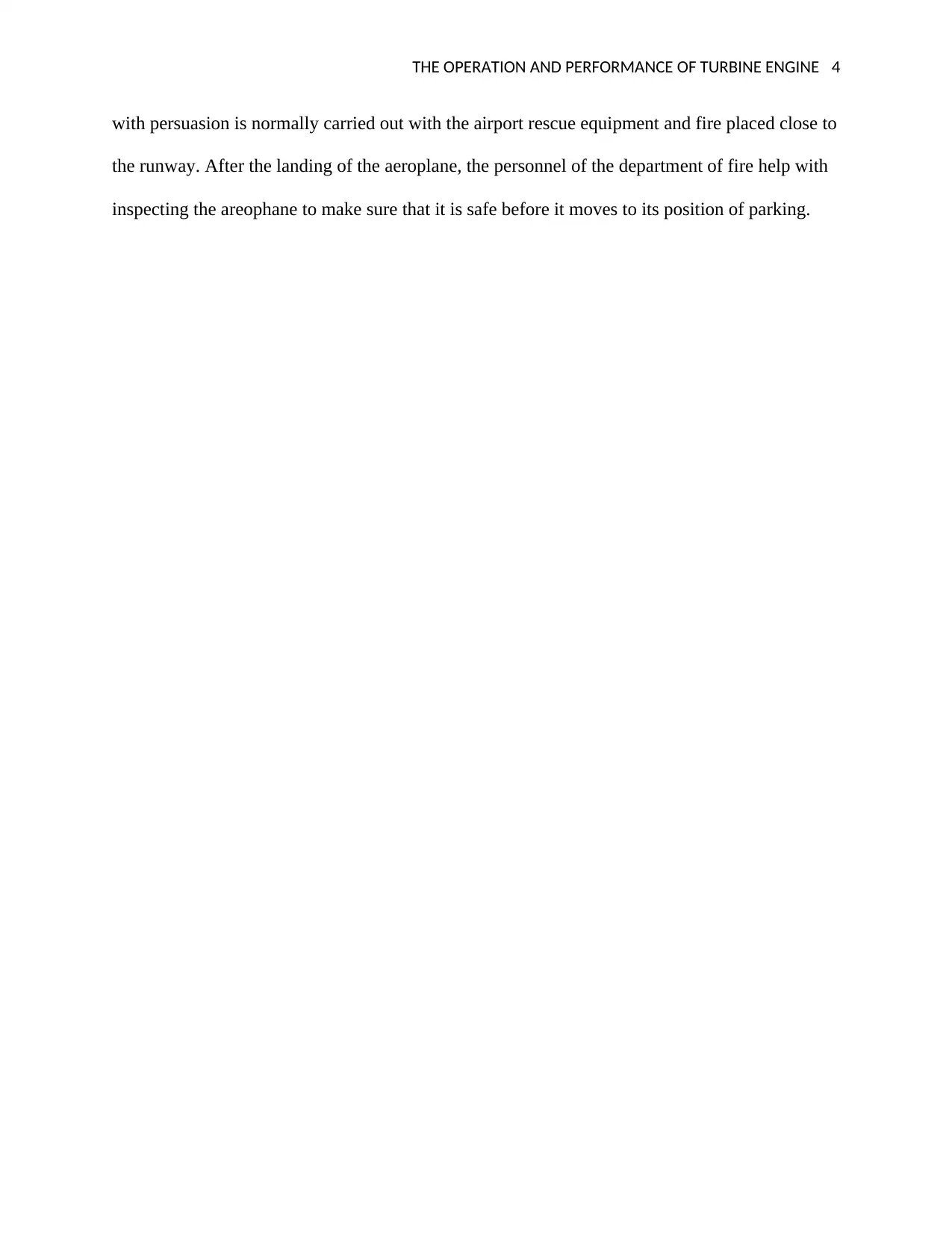
THE OPERATION AND PERFORMANCE OF TURBINE ENGINE 4
with persuasion is normally carried out with the airport rescue equipment and fire placed close to
the runway. After the landing of the aeroplane, the personnel of the department of fire help with
inspecting the areophane to make sure that it is safe before it moves to its position of parking.
with persuasion is normally carried out with the airport rescue equipment and fire placed close to
the runway. After the landing of the aeroplane, the personnel of the department of fire help with
inspecting the areophane to make sure that it is safe before it moves to its position of parking.
Paraphrase This Document
Need a fresh take? Get an instant paraphrase of this document with our AI Paraphraser
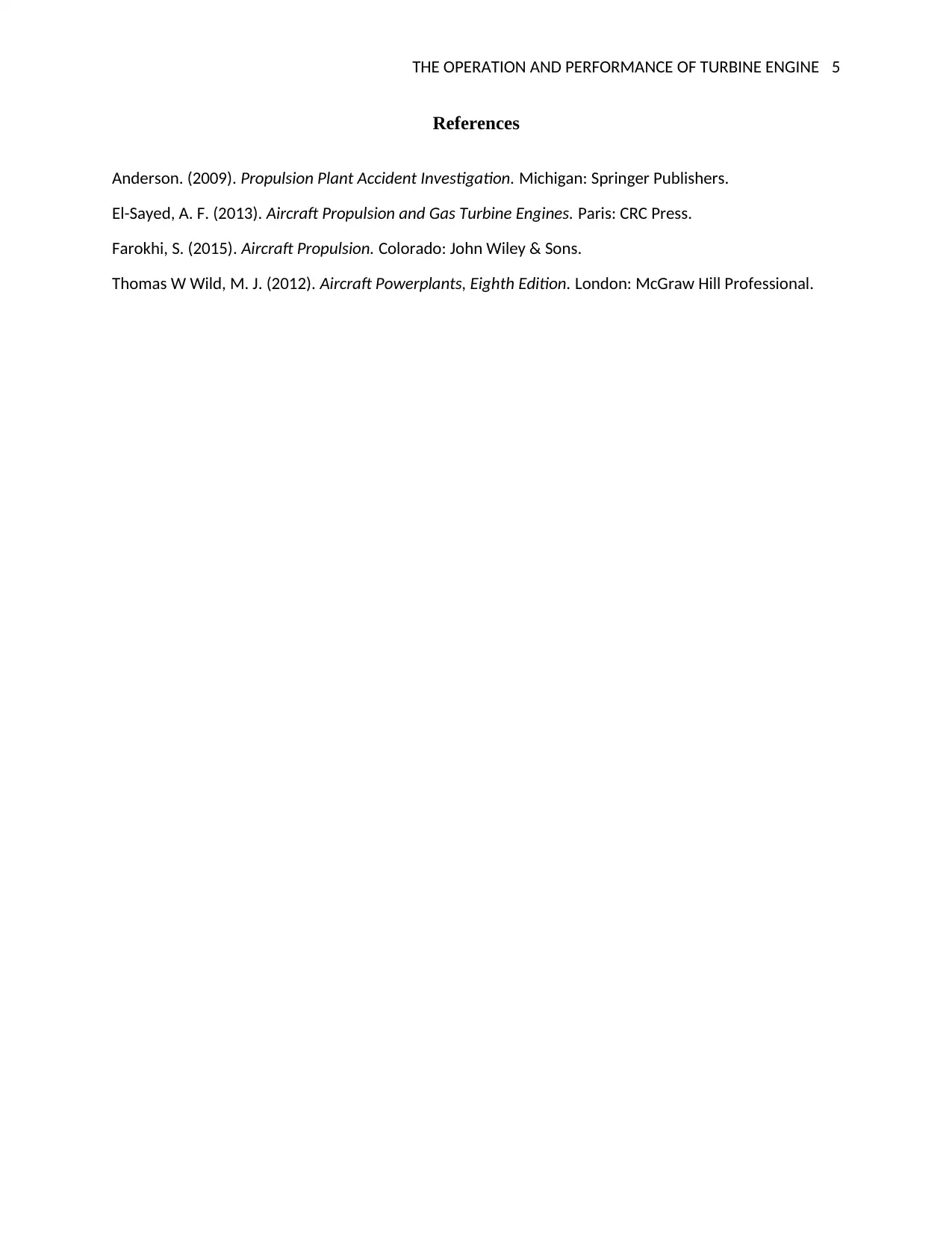
THE OPERATION AND PERFORMANCE OF TURBINE ENGINE 5
References
Anderson. (2009). Propulsion Plant Accident Investigation. Michigan: Springer Publishers.
El-Sayed, A. F. (2013). Aircraft Propulsion and Gas Turbine Engines. Paris: CRC Press.
Farokhi, S. (2015). Aircraft Propulsion. Colorado: John Wiley & Sons.
Thomas W Wild, M. J. (2012). Aircraft Powerplants, Eighth Edition. London: McGraw Hill Professional.
References
Anderson. (2009). Propulsion Plant Accident Investigation. Michigan: Springer Publishers.
El-Sayed, A. F. (2013). Aircraft Propulsion and Gas Turbine Engines. Paris: CRC Press.
Farokhi, S. (2015). Aircraft Propulsion. Colorado: John Wiley & Sons.
Thomas W Wild, M. J. (2012). Aircraft Powerplants, Eighth Edition. London: McGraw Hill Professional.
1 out of 5
Related Documents
Your All-in-One AI-Powered Toolkit for Academic Success.
+13062052269
info@desklib.com
Available 24*7 on WhatsApp / Email
![[object Object]](/_next/static/media/star-bottom.7253800d.svg)
Unlock your academic potential
Copyright © 2020–2025 A2Z Services. All Rights Reserved. Developed and managed by ZUCOL.





